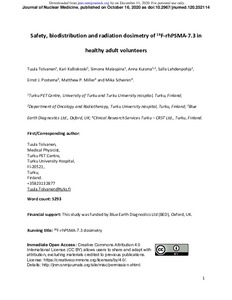Safety, biodistribution and radiation dosimetry of 18 F-rhPSMA-7.3 in healthy adult volunteers
Kuisma Anna; Malaspina Simona; Scheinin Mika; Postema Ernst J.; Tolvanen Tuula; Lahdenpohja Salla; Miller Matthew P.; Kalliokoski Kari
Safety, biodistribution and radiation dosimetry of 18 F-rhPSMA-7.3 in healthy adult volunteers
Kuisma Anna
Malaspina Simona
Scheinin Mika
Postema Ernst J.
Tolvanen Tuula
Lahdenpohja Salla
Miller Matthew P.
Kalliokoski Kari
Society of Nuclear Medicine and Molecular Imaging
Julkaisun pysyvä osoite on:
https://urn.fi/URN:NBN:fi-fe2021042822898
https://urn.fi/URN:NBN:fi-fe2021042822898
Tiivistelmä
This first-in-human study investigated the safety, biodistribution and radiation dosimetry of the novel 18F-labeled radiohybrid prostate-specific membrane antigen (rhPSMA) positron emission tomography (PET) imaging agent, 18F-rhPSMA-7.3. Methods: Six healthy volunteer subjects (3 males, 3 females) underwent multiple whole-body PET acquisitions at scheduled time points up to 248 minutes after the administration of 18F-rhPSMA-7.3 (mean activity 220; range, 210-228 MBq). PET scans were conducted in three separate sessions and subjects were encouraged to void between sessions. Blood and urine samples were collected for up to 4 hours post-injection to assess metabolite-corrected radioactivity in whole blood, plasma and urine. Quantitative measurements of 18F radioactivity in volumes of interest (VOIs) over target organs were determined directly from the PET images at 8 time points and normalized time-activity concentration curves were generated. These normalized cumulated activities were then inputted into the OLINDA/EXM package to calculate the internal radiation dosimetry and the subjects' effective dose. Results: 18F-rhPSMA-7.3 was well tolerated. One adverse event (mild headache, not requiring medication) was considered possibly related to 18F-rhPSMA-7.3: because of the temporal association with 18F-rhPSMA-7.3 injection, a causal relationship could not be excluded. The calculated effective dose was 0.0141 mSv/MBq when using a 3.5-hour voiding interval. The organs with the highest absorbed dose per unit of administered radioactivity were the adrenals (mean absorbed dose, 0.1835 mSv/MBq), the kidneys (mean absorbed dose, 0.1722 mSv/MBq), the submandibular glands (mean absorbed dose, 0.1479 mSv) and the parotid glands (mean absorbed dose, 0.1137 mSv/MBq). At the end of the first scanning session (mean time, 111 min post-injection), an average of 7.2% (range, 4.4-9.0%) of the injected radioactivity of 18F-rhPSMA-7.3 was excreted into urine. Conclusion: The safety, biodistribution and internal radiation dosimetry 18F-rhPSMA-7.3 are considered favorable for PET imaging.
Kokoelmat
- Rinnakkaistallenteet [19207]
